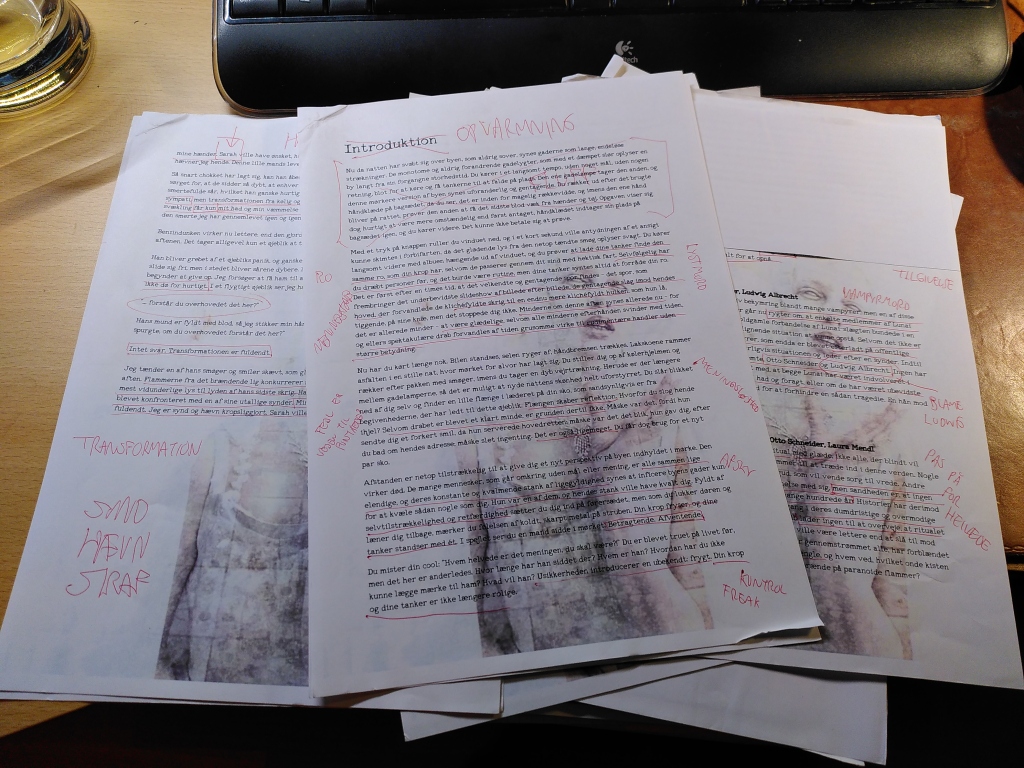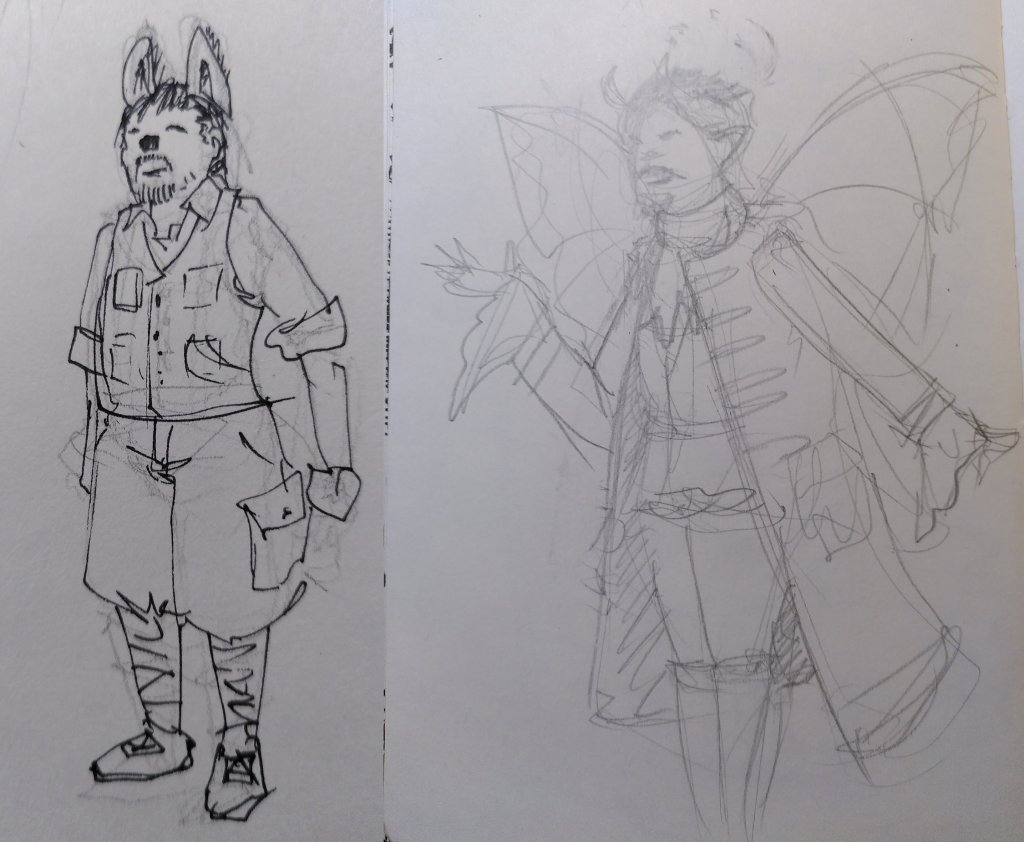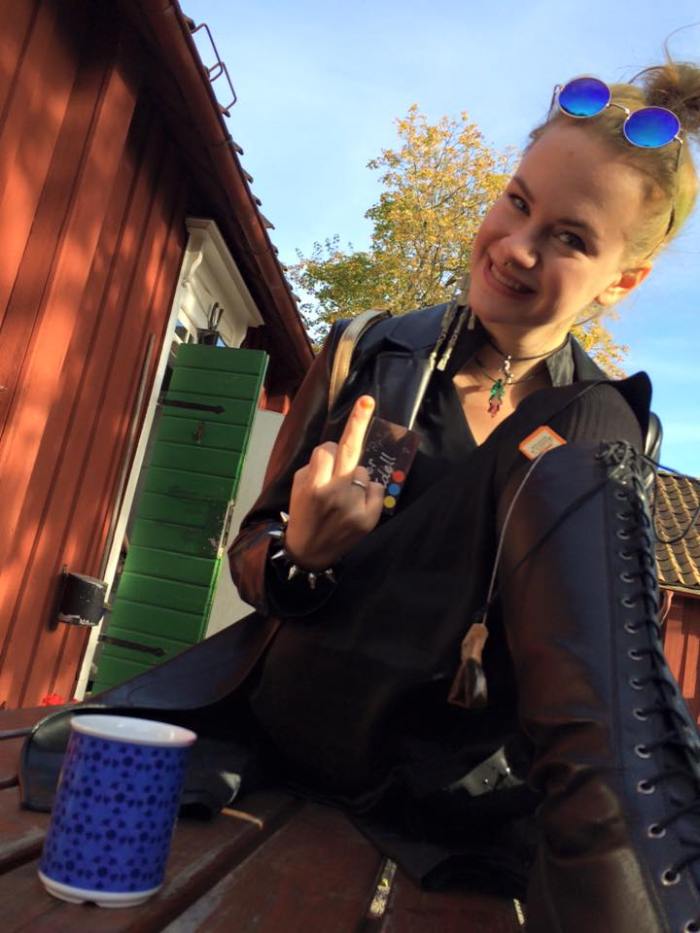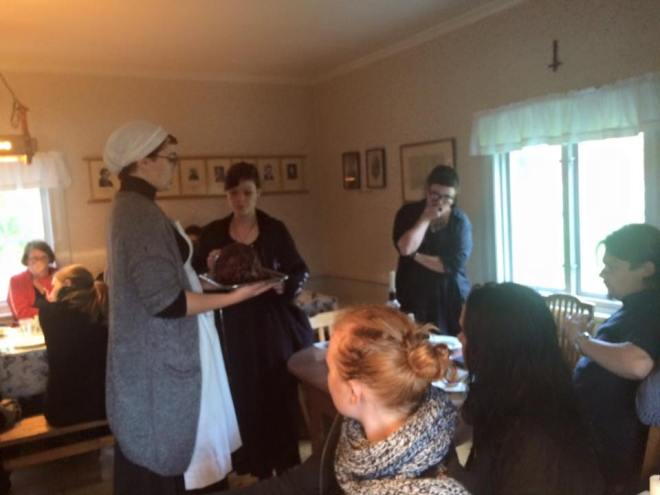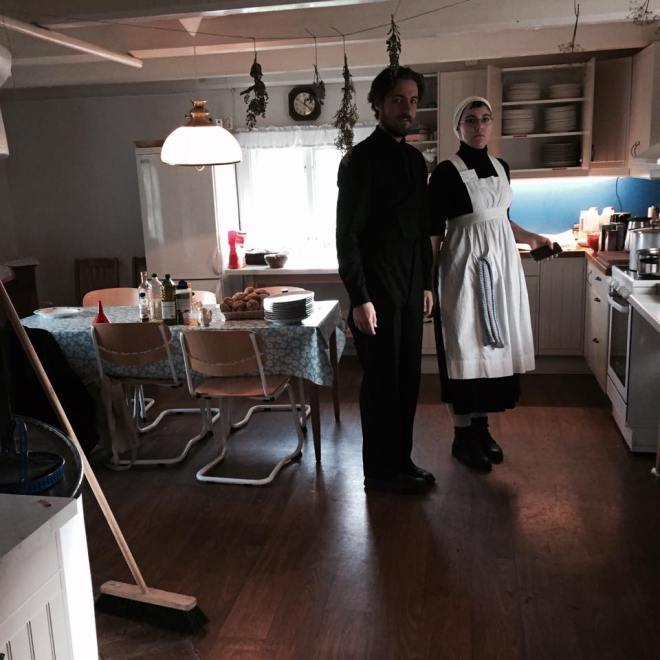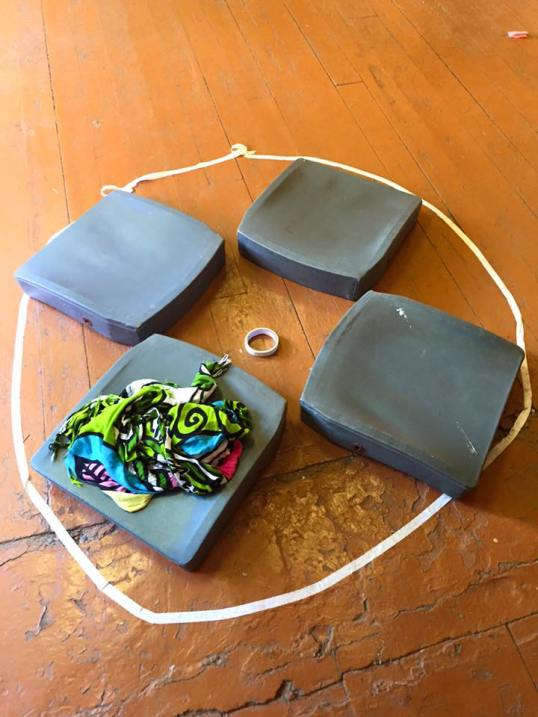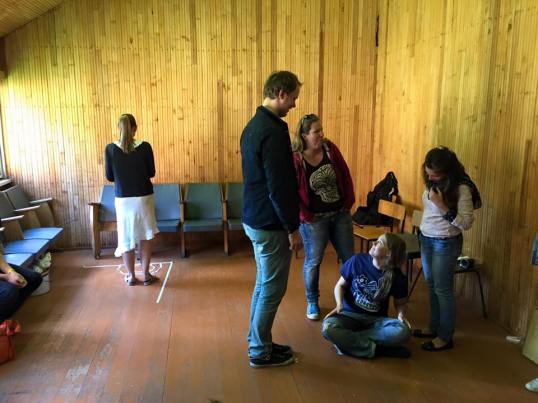Review of the larp “Helicon” by Narrators Inc.
Helicon is a small, intimate luxury larp about a group of divinely talented artists and the muses they had enslaved to make them that way, of course inspired by Neil Gaiman’s Callipe, (from The Sandman comic or tv series). It’s a very Nordic larp, based on mutual trust and collaboration among the players, to take charge of their own stories and follow their characters into dark places.
I wrote this long and, let’s face it dry, review of the second run in 2024, but to really tell you of the larp I’ll have to tell you about my character, Taylor Montgomery the tragic playwright. So I’ll tell you a few fragments like this about them as we go through what the larp was like:

Taylor was an innocent, if dramatic, teenager, drawn into making a bargain far beyond their understanding, in order to be part of their brother’s social circles at university.
The larp is run under the umbrella of Narrators Inc and the designers of the larp are Maria Pettersson and Katrine Wind, both experienced larpwrights. I can trace both their styles and interests in this larp, to great effect. I’m a loyal fan of Katrine and Maria makes the sort of larp I wish I was sexual enough to attend.
They truly, deeply loved Melpomene, the radiant Muse of Tragedy, and that is all that is and ever will be important about Taylor.
Signup is in pairs (or threes) [Edit: Signup was also possible solo, where you’d be matched up by the organizers] of Inspired-Muse bonds and the majority of drama comes from tensions within that bond. It’s always a very profound relationship, with dimensions of romance, subjugation, needs, sex and philosophy that consumes both sides. The larp hosts a cosy 29 players, divided half between inspired artists and their captive muses, for a tight two-day run, friday afternoon to saturday night for play, plus workshopping and socializing at either end. It was held at Broholm Castle, a baroque manor hotel, full of character. It is one of the best locations I’ve larped at, both for the incredibly luxurious accomodations and for the playspace it provides. The rooms and suites are all quirkily loaded up with antiques and family mementoes, but it also modernized bathrooms and truly gourmet multi-course meals. And a moat.
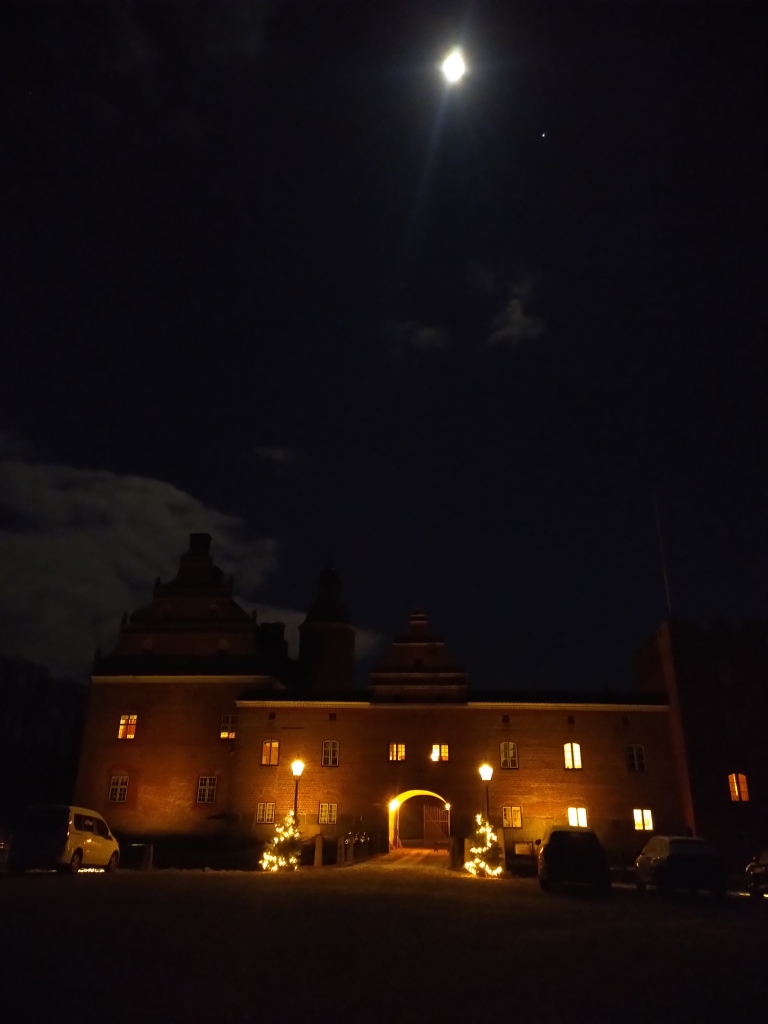
The location is also eminently playable, most activity takes place in the ground floor of the castle, where a series of seven parlours and halls of various sizes and characters form an en suite circle, with an extra library and billiards room off the end for more private affairs. This means it takes only a few minutes to move through the spaces and get a picture of almost all the play. Meals are held in the second floor neo classical dining hall, full of greek statuary and reliefs with plenty of space left around the tables for drama. It is unfortunately full of hard surfaces and the noise level quickly reaches levels where my old, abused ears can’t follow. But that is really the only critique I can level at the location, except maybe that some rooms and the breakfast restaurant were across the rain-slicked cobble courtyard. And there are a bunch of little extra spaces for the curious exploring types, such as the neolithic artifacts museum or the incredibly creepy toy museum in the eaves of the roof.
Precious time
But the space that really sets this game apart, was the timeline. The first half day is checking in and workshopping. The workshop was an incredibly lean experience, very little time wasted or misspent. The major part was set aside for a schedule of calibrations with key relations and outlining what was going to happen during the first act. There were a few excercises and rehearsals of ritual choreography or mechanics. And almost no repetition of material from the pregame materials. It’s nice to be trusted that all players are committed and take their preparations seriously, both before play and in the workshop. I really wish this was the norm. Another lovely factor is that the divide act structure made it possible to only recieve information that would be relevant for the immediate future, and kept the rest until we needed to know it in later breaks. This all left good time to get into our rooms and costumes, or picking up any extra calibrations before play, while still having time for a solid chunk of first act play friday evening.
Taylor was a genius playwright, the most astute dissector of the faults of humanity and eminent at showing the awful things we do to each other.
Before we start on the play itself, I’ll stay with the offgame segments. Play ends on friday night and all sleep and breakfast are delightfully offgame, followed by some recalibrations and preparations for the second act. After which there is a mandatory naptime, where you get “sent to your rooms” for an hour to reconstitute before the third and final act with saturday night dinner and final crescendo. And then a lovely little postgame party. Sunday is all hangover breakfast and checking out of the rooms in good order.
Play structure
This is one of those larps you sign up for in a couple (or thruple in our case, but more on that later). The core play experience circles tightly around that one connection, plus a handful of external relationships. And generally a cast intimate enough that it’s never weird to pick up a thread with anyone in play. It is structured by the three acts, which get progressively more intense. The first has both a strong kickoff and time to find your character, the second a chance to unfold play in new directions, while the third pushes relentlessly towards climactic resolution. In addition theres three planned rituals, three meals, one or two flashbacks and a one-hour party during play.
Noone really ever understood Taylor, except maybe his Melpomene. The beauty of their brother Thomas was that they were like perfectly matched unexplorable lands that could never been grasped at the same time.
The rituals are big collective affairs. The larp starts with one, a big, dramatic ritual punishment and humiliation of the muses for trying to escape. It’s an explosive start that really shows the relationships of the artists and the muses at their worst (for now), it’s a real kick start and even though I am not good with cold-starting big emotions I was very grateful for it. It is followed by a lovely three course dinner with everyone wound up and resentful or out to cause trouble. I liked having an explosive start, that quickly set things in motion that made it possible to settle into my character and relationships without losing steam.
Taylor was wicked funny and witty with their loyal longtime friends and literary equals inspired by other Muses.
The next two acts have similar planned scenes, meals and rituals that frame the stretches of just playing. The timing and design of those fixed points really impressed me, they didn’t feel forced or got in the way of character flow. Instead they flipped the script and/or turned up the heat in various ways, that made it very easy to keep escalating relationships and exploring your character. My favourite design choice would probably be the flashback to the university party where we callously distributed the muses amongst ourselves. Not only was it great to play the character as younger and more alive, but the fallout from how they actually did it, added a very beautiful dimension to the relationships to the muses going forward. Which in our case led to a very poignant reveal at the very end.
They felt more at ease around the Muses than with any of their human friends, Taylor was maybe never meant for this world of flesh and limitations.
Play was scored with a soundscape from the great larp composer Anni Tolvanen. Both with a haunting original theme and by DJ’ing the background music. I love when larps don’t use popular music for the theme, so I don’t have to fear bleed in the supermarket afterwards and having an original work was very fitting to this one. The background was ambient scapes, era music and movie soundtracks. It’s always tricky when you recognize a song during play, but we had a great little sync, when a scene where the need for inspiration was very much like a drug lined up with the theme from Requiem for a Dream. We all picked up on it and steered the intensity to match the movements of the music.
The organizers make it very clear from the start that it is up to you as a player, to take charge of your own narrative, but then they also shower us with scheduled events and opportunities that you can’t help but excalate and go new places all the time. Ending the larp feels more like landing a fiesty pegasus, than anything resembling authorial control.
Cast and quality
This was a high barrier larp, with the biggest two being the price (€630) and that signup was as a couple. (I’m usually too socially awkward for couple signups, but the premise made me too excited when I was surprised with an opportunity to sign up, so I even asked if I could be the third wheel in an already signed up pair.) I don’t want to imply that wealthy people larp better, but the cost also means that it’s more of commitment to go. And my favourite co-players are always those that are genuinely excited to be at -this- particular larp – and willing to pay various costs to do so.
Taylor hated the limelight and all that followed from it. But Taylor could not but keep writing plays even if they inevitably led to that place of filthy fame and grubby glory.
It also helps that the two designers have established a brand for themselves, that lure in the right sort of people for the right sort of larp. I am very partial to Katrine Wind’s brand of safe and intense design, I also love Maria Petterson’s ideas for those same qualities, but the larps are often too sexual for me. But I really like the players of such larps. And I got two of the best to play with in this case.

All this to say that the particpants were all highly motivated, chose carefully and a lot of us had a good idea of what to expect. And that is part of what allowed the organizers to trust us to take care of ourselves and each other. That removes a lot of work establishing trust and taking the experience seriously. It’s a delight to feel in the hands of responsible, mature co-players. A delight that makes it easier to take the scary steps into deep intimacy.
Character class
I also liked that my character had only a handful of relations outside the core Muse-Inspired shape. It was only a handful and they were mostly easy friendships without friction, plus a mirrored pair of inspiration/sexual illoyalties that set up some delectable double morals. Organizers will often be overly generous with relationships, making it hard to distinguish which are important and which are going to fade into obcurity. But when all the characters have known each other atleast a decade and a half, you only need to know the important ones. I don’t think two of the friendships ever impacted play itself, but the warmup scene we did together was an important puzzle piece for me in building the character, the others gave perspectives and small side stories that echoed the main themes of love and need.
A long, private and dull life of noble mediocrity should’ve been Taylor’s natural fate and that was the heaven they‘d stopped dreaming of.
I do think the writing of the character could’ve used a harsher editor, to make it match the lean design of play itself: There’s a lot of detailed backstory that could be pruned, in favour of letting the players improvise with a clearer and more evocative image of what is central to the character. But this is really the only thing I will put up as a negative point for the larp, since the actual playtime was such a smooth affair.
The experience
To talk about what playing was like, I must invoke the muses themselves. First off we must go by Aristotle and discuss the difference between Lyrical and Epic poetry. Epic poetry is the telling of grand -stories-, Calliope inspires us to develop our characters and follow their changing the world, themselves and each other. But for me, this larp lay in the hands of her gentler sister Erato: Lyrical poetry is about a moment, it’s about all the dimensions of a feeling, the space inside us in a single instant.
Taylor was a fucking morbid creep, who loved making others uncomfortable and messing with their heads if they came too close.
I couldn’t tell you a meaningful story of my character. I don’t think anything changed inside them for the entire duration of the larp, circumstances just drew out different sides of the same darkness. As a lyrical poem shows us different aspects of love, this one led me around a much darker place in very poetic ways. There were beautiful rhyming themes within the other players characters, swells of emotion and a tight structure that let me improvise freely.
There was no Taylor any more. There was only a deep, unending hunger for tragic inspiration inside a hollowed out human.
And that is truly what I appreciated most about this larp, how effortlessly I could play it. It started in the very first moments of play, in the ritual punishment of the muses, we just fell perfectly into our roles and their feelings. And then a thing happened and I flowed right into another interesting emotional space, whose consequences then led to new places. And it just kept going like that for the rest of the larp. Some of it came about from design choices, most of it from superb co-players and a few instances of larp magic. But it was a constant flow of opportunities. At one point I had a left an intense dinner scene and found myself alone on the ground floor. And as I sat brooding by the fireplace, I realized I don’t think anyone could enter the room, without it leading to something profound for me. And then of course my radiant muse Melpomene walked in. Perfection.

And she truly owned it all, the muse of Tragedy. It was such a doomed tale for everyone, inevitable from the start, but with just a sliver of a chance that it might not. If only we’d be able to break from our nature. But noone could. Can anyone really?
In conclusion
I know that a lot of larpers have a hard time with signing up in pairs (I haven’t felt a strong enough need to overcome my awkward about it before Helicon), but I think it is the correct choice for this one. And that it’s a good larp for trying it out, since the smoothness and open design, with focus on trust and communication, makes it easy to check in and calibrate the intensity and intimacy of the relationship as you go along. That and the fact that there’s a hard practical and thematic upper limit on how sexy you can make it.
Taylor saw tragedy so clearly that that was all they could see and all that they would ever be able to create. Even in their own life.
It does list as quite expensive though, especially plus travel and moderately ambitious costuming. Though when the location and catering is considered it’s really not unfairly priced. I do think you should want to pay the money because you think that the larp is worth it, not just for a weekend of luxury in costume, since play is so intense and demanding. But if I instead set up an equation of time + money as the cost vs the experience you get, this one really shines from the amount you get in a tight package.
They were so tired of it all. Fifteen years a paragon of tragedy, felt like more than a lifetime. And long enough for Taylor to long for the sweet release of death.
Despite the larp being such an intimate scale, I do think it has acceptable replay value, since you’re laser focused into your own drama and only have a little idea of what the rest is playing out. And the “plot” isn’t complex enough to mess up with foreknowledge. Especially if you play the other half from your first trip to Mount Helicon, Inspired to Muse or vice versa. I’ll probably not race to sign up myself, until this one is settled in my soul a bit more and others get a chance to go, but if a reserve is called for, I’d gladly do my duty.

This was the larp I’ve been the most excited for in a long time. I love small, intimate larps. And the themes of art, occultism and toxic relationships were just too juicy. And I can honestly say I got everything I had hoped for. I believe larp is too subjective for perfection or universal greatness, so I’ll stick with say that this is some of the best design choices that I’ve had the pleasure of playing in. It maybe wasn’t the most intense, transformative or poignant experience I’ve had. But it was really, really good and definitely competitive on those fronts, if I’d been younger and less jaded. I struggle to think of what could’ve been done better in making a playable larp out of the core idea.
Taylor got the punishment they fucking deserved, at the hands of their vengeful mistress Muse in the end:
More.
